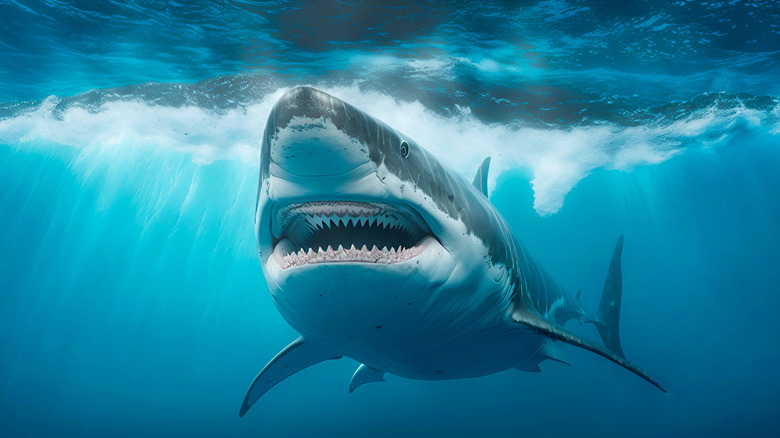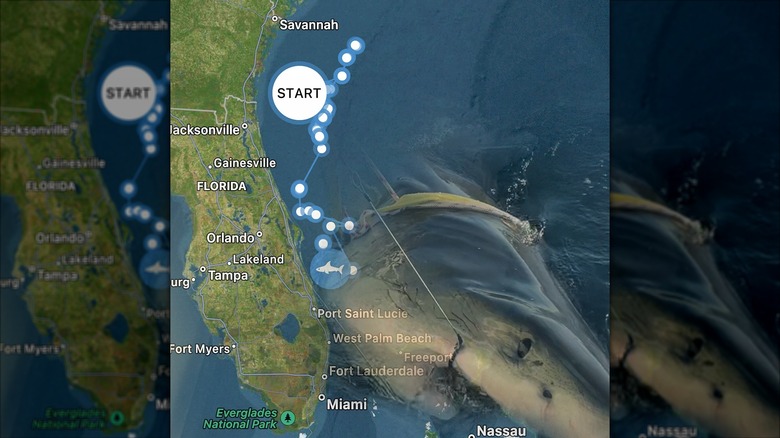Contender The Great White Shark Is One Of The Atlantic's Largest Ever Tagged
Is there anything more terrifying to emerge from the deep blue than the great white shark? Movies like the 1975 thriller "Jaws" would have most believe an encounter with the fearsome fish would be guaranteed terror. And while they are apex predators, 2024 saw only seven fatal shark attacks in the United States compared to 2023's 10. The majestic great white shark certainly gets a bad rap, and to many, it represents the complex underwater ecosystem. Still, with the recent tagging of the biggest great white shark on record in the Atlantic ocean, it's hard to imagine that no one would be intimidated by the shark now named Contender.
The non-profit group OCEARCH, which specifically focuses on shark tracking, tagged the male white shark 45 miles off of the Florida-Georgia coast on January 17, 2025. The team behind the tagging posted a video of the gigantic shark on TikTok and reported its impressive size of 13 feet, 9 inches and 1,653 pounds, which is heavier than six full-size refrigerators. Estimated to be in his early 30s, Contender isn't just remarkable in size; his tagging also marks a rare chance for researchers to study the behavior of adult male great white sharks, which aren't as widely recorded in scientific datasets.
@ocearch Contender is the largest male white shark ever caught, SPOT tagged, released and now studied in the NW Atlantic white shark population! The SPOT tag deployed on Contender will provide valuable real-time data for approximately five years, helping us track his movements and understand his migration patterns. Additionally, we've collected important biological samples, including urogenital material, which are currently being analyzed. Follow Contender's journey on the OCEARCH Global Shark Tracker www.ocearch.org/app #OCEARCH #SharkTracker #WhiteSharks #OceanConservation #SharkResearch #FactsOverFear #MarineScience
As of March 12, 2025, Contender has traveled more than 290 miles since his tagging in early January. With its Global Shark Tracker, OCEARCH continues to track Contender's trajectory, along with several other sharks and aquatic life. With growing concerns that the great white shark could join the list of breeds that don't exist anymore (including many cute dogs), research and support for specimens like Contender are critical in addressing the majestic deep-sea fish's conservation challenges.
Contender's importance in the continued conservation of great white sharks
In OCEARCH's continued efforts to track the patterns of great white sharks, Contender stands out as unique, as the organization had largely only tagged juveniles or subadults before. For context, male sharks reach sexual maturity at around 26 years of age, while females can give birth at around age 33. Moreover, the great white shark boasts an incredibly long lifespan, often living for over 70 years old.
Contender, the only sexually mature shark that OCEARCH has tagged since beginning operations in 2007, shows how vital the finding is for obtaining statistics on the great white shark. This luck may align with reports of a population increase in Cape Cod, which feeds into the Atlantic Ocean where Contender was found, including 100 new sharks identified in 2023 alone, bringing the local population to 700.
Yet, Contender and other great whites still face challenges. Speaking with Eco Magazine in July 2024, Les Noble, professor of aquatic biosciences at Norway's Nord University, noted, "Successful conservation requires recognition of management units, but this has been unavailable for white sharks, which were suspected to exist as a single global population." Noble further expands on the challenges facing great white sharks — pollution, fishing, and food scarcity — along with the lack of globally organized conservation efforts that may lead to extinction. Ultimately, as scary as Contender may seem in scale, his discovery and tagging could help conservation efforts in big ways.
Want more animal discoveries? Check out the unique "one-in-a-million" animal spotted in Western Texas.

